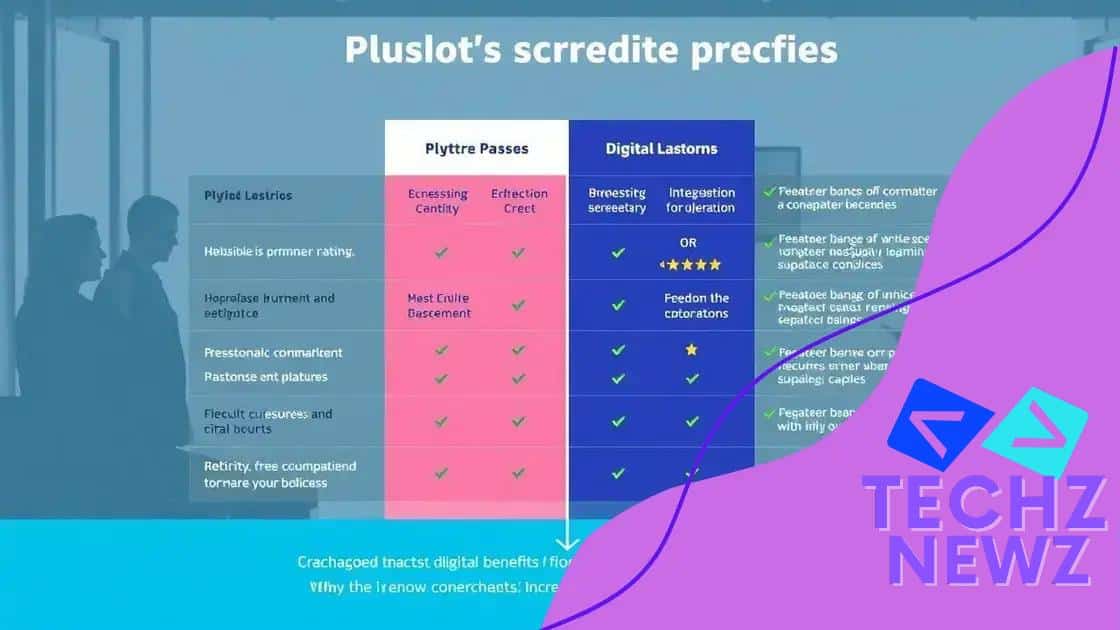Digital platforms for benefits enrollment and management

Digital platforms for benefits enrollment streamline the selection and management of employee benefits, enhancing efficiency, user engagement, and providing valuable insights through analytics for HR teams and employees.
Digital platforms for benefits enrollment and management are transforming how companies handle employee benefits. They streamline processes and improve user experiences, but have you considered how these platforms can benefit your organization? Let’s dive into their advantages.
Understanding digital platforms in benefits management
Understanding digital platforms in benefits management is crucial for modern businesses. These platforms offer streamlined solutions that help organizations optimize how they handle employee benefits. Many companies are shifting towards digital solutions to enhance efficiency and user experience.
What are digital benefits platforms?
Digital benefits platforms are software solutions designed to simplify the enrollment and management of employee benefits. They provide a user-friendly interface for employees and HR professionals alike. By utilizing these platforms, businesses can save time and reduce errors in benefits management.
Key advantages of using digital platforms
There are several benefits to adopting a digital platform for benefits management:
- Increased efficiency: Automating processes reduces time spent on administrative tasks.
- Improved accuracy: Digital solutions minimize human errors during data entry.
- Enhanced employee experience: A user-friendly interface makes it easier for employees to navigate their benefits.
- Data insights: These platforms can analyze data to provide valuable insights into benefits utilization.
As organizations continue to grow, the need for efficient benefits management becomes more pronounced. With the right digital platform, companies can manage a wide array of benefits more effectively. Furthermore, many platforms integrate seamlessly with existing systems, ensuring a smooth transition.
Understanding these platforms can empower HR teams to make informed decisions. Choosing the right solution involves evaluating different software options based on specific organizational needs. By aligning the platform’s features with business goals, companies can leverage technology to enhance their benefits administration.
Long-term impact of digital platforms
The long-term impact of adopting digital platforms in benefits management can be significant. Over time, businesses may notice lower administrative costs and a more engaged workforce. As digital solutions evolve, staying updated on the latest features can help organizations remain competitive. Embracing technology not only simplifies processes but also fosters a culture of innovation within the workplace.
Key features to look for in a benefits enrollment platform
When selecting a benefits enrollment platform, understanding the key features is vital for making an informed decision. These features not only enhance the user experience but also streamline the enrollment process for both employees and HR teams. Knowing what to look for can save time and increase satisfaction.
User-friendly interface
A user-friendly interface is essential. Employees should easily navigate the platform without confusion. Training sessions can be minimized with intuitive designs. A smoother user experience encourages more employees to engage with their benefits.
Customization options
Customization is another important feature. Every organization is unique, and the ability to tailor the platform to meet specific needs is valuable. This can include:
- Branding: The platform should reflect your company’s logo and colors.
- Benefit selections: Employers should customize which benefits are offered based on employee needs.
- Personalized communications: Automated messages that can be personalized enhance the connection.
- Languages: Multi-language support broadens accessibility.
Integrating these features will ensure that the enrollment process is relevant to the workforce. It empowers employees to make informed choices about their benefits. An informed employee is a satisfied employee, so taking time to evaluate customization capabilities is worth the effort.
Robust reporting tools
Effective reporting tools are essential for monitoring benefits utilization. These tools help HR teams analyze data easily. Look for platforms that provide:
- Real-time analytics: Understand who is enrolling and which benefits are popular.
- User engagement scores: Track how effectively employees are interacting with their benefits.
- Compliance tracking: Ensure you meet regulatory standards without extra effort.
Investing in a platform with robust reporting capabilities proves to be beneficial over time. They allow employers to refine their offerings based on insights gained from employee engagement.
Comparing popular digital platforms for benefits

When it comes to comparing popular digital platforms for benefits, various factors come into play. Each platform offers unique features, pricing models, and user experiences. Making the right choice can significantly impact employee satisfaction and administrative efficiency.
Feature comparison
Features are a key aspect to assess. Some platforms focus on simplicity, while others provide comprehensive functionalities. Key features to consider include:
- Usability: The platform should be easy for employees to navigate.
- Customization: Look for options to tailor the platform according to your company’s needs.
- Integration: Ensure it integrates well with current HR systems.
- Reporting: Check if it offers robust analytics for better decision-making.
By comparing these features across platforms, businesses can align their needs with the right solution.
Pricing models
Another vital aspect in comparing platforms is the pricing structure. Different platforms have various pricing models, including:
- Monthly subscriptions: Fixed fees charged each month.
- Per employee charges: Based on the number of employees enrolled.
- One-time fees: Upfront payments for lifetime access.
Understanding these models can help businesses find a cost-effective solution that doesn’t compromise on quality.
Moreover, reading user reviews can provide insight into the performance and support of each platform. Companies should not solely rely on marketing materials; real user experiences often reveal the strengths and weaknesses of digital platforms for benefits.
Ultimately, taking the time to compare popular platforms ensures selecting a solution that meets both employee expectations and organizational goals.
How to integrate these platforms into your business
Integrating digital platforms for benefits into your business can enhance efficiency and improve employee satisfaction. By following careful strategies, organizations can ensure a smooth integration process.
Assess your current systems
Start by evaluating your existing systems. Understanding how current processes work is essential to identify where digital platforms can fit in. Consider how your HR and payroll systems operate, as well as the technology your employees are accustomed to using.
Choose the right platform
Selecting the right platform is crucial for integration success. Look for features that complement your current systems, such as:
- Compatibility: Ensure the platform integrates with existing HR software.
- User experience: Choose a platform that your employees find easy to navigate.
- Support services: Good customer support can make a difference during the integration process.
Once a platform is selected, work closely with the vendor to align their system with your needs. This collaboration helps clarify any technical details required for a seamless transition.
Prepare your team
Getting your team on board is vital. Implement training sessions to familiarize everyone with the new platform. Provide resources, such as training videos or manuals, to help employees engage with the system confidently. Encouraging open communication can address concerns and promote a positive attitude towards the change.
Additionally, setting up a pilot program allows a small group to test the platform before a full rollout. This trial can help gather feedback and make necessary adjustments before a comprehensive launch.
Monitor and adjust
After integration, closely monitor how the platform functions within your business. Collect feedback from users about their experiences. Regularly check analytics to see how employees engage with the platform. If issues arise, address them swiftly to ensure a productive environment for everyone.
Creating a supportive culture around new technology can significantly impact its acceptance. By embracing digital solutions, businesses can streamline benefits management efficiently.
Best practices for maximizing platform efficiency
Maximizing platform efficiency is crucial for optimizing the use of digital platforms in benefits enrollment and management. By implementing effective practices, organizations can streamline processes and enhance user experience.
Regular training sessions
One of the best practices is to conduct regular training sessions for employees. Ensuring that workers are familiar with the features of the platform improves their confidence. This can lead to better engagement with their benefits. Frequent training updates keep everyone informed about new features and enhancements.
Stay updated with platform changes
Keeping track of updates to the platform is also important. Many providers regularly release new features that enhance functionality or user experience. To make the most of these updates:
- Review release notes: Regularly check the release notes for any new features or improvements.
- Engage support: Reach out to customer support for demonstrations or explanations of new functionalities.
- Solicit feedback: Gather employee feedback on how updates impact their user experience.
By staying informed about platform changes, businesses can ensure that they make timely adjustments to maximize efficiency.
Monitor performance metrics
Monitoring metrics is critical for identifying areas that need improvement. By analyzing data, companies can discover how well the platform is being utilized. Key performance indicators (KPIs) to consider include:
- Enrollment rates: Track how many employees are successfully enrolling in benefits.
- User engagement: Measure how often employees log in and utilize features.
- Support requests: Analyze the number and type of support inquiries to identify common issues.
Using these metrics helps organizations refine their approach and make informed decisions to improve platform usage.
Encourage feedback and enhancements
Lastly, fostering an open environment for feedback is essential. Encourage employees to share their thoughts and experiences with the platform. This can lead to valuable insights on improving usability. Companies can create suggestion boxes or conduct surveys to gather input. This two-way communication can lead to enhancements that directly meet employee needs.
By adopting these best practices, organizations can maximize the efficiency of their digital platforms, leading to enhanced benefits management and improved employee satisfaction.
In conclusion, effectively managing benefits enrollment and leveraging digital platforms can significantly enhance employee satisfaction and streamline HR processes. By understanding the features of these platforms, integrating them smoothly into your business, and following best practices for maximizing efficiency, organizations can create a productive benefits environment. Encouraging ongoing communication and feedback fosters an atmosphere of continuous improvement. Implementing these strategies will not only streamline benefits management but also ensure that employees feel valued and well-informed about their options.
FAQ – Frequently Asked Questions about Digital Platforms for Benefits Enrollment
What are digital platforms for benefits enrollment?
Digital platforms for benefits enrollment are online systems that streamline the process of selecting and managing employee benefits, making it easier for both HR teams and employees.
How do I choose the right platform for my business?
Consider factors such as usability, integration capabilities, customization options, and the specific needs of your workforce when selecting a benefits platform.
What are the benefits of integrating a digital platform?
Integrating a digital platform can improve efficiency, reduce administrative burdens, enhance employee engagement, and provide better insights through analytics.
How can I ensure my employees are comfortable using the new platform?
Regular training sessions, continuous support, and encouraging feedback can help employees feel more confident and engaged with the platform.





